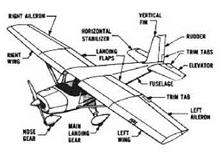The Cowling
The “cowling” is an important part of the powerplant, even though it doesn’t produce any horsepower at all. The cowling is the curved metal covering over the engine. It’s not there just to give the airplane a stylish flair. Its most important function is to smooth the surface around the engine.
As we’ll see in greater detail shortly, air flows better over a smooth surface than a rough one. Without some kind of covering to smooth the way, the surface of an engine diverts air into any number of crevices and hiding places. Because it hides the rough edges, the cowling, which is usually made of lightweight sheet aluminum or molded Fiberglas, actually enables airplanes to fly faster—not to mention make a fashion statement!
That portion of the airplane that houses pilot and passenger is called the “fuselage” (pronounced FYOO-suh-lazh). The fuselage contains the cockpit, the passenger cabin, and the baggage compartment in most small airplanes. The fuselage also shelters the airplane’s sensitive instruments.
|
Knowing how the parts of a plane fit together is a key part of flying. (FAA Flight Training Handbook) |
|
On Course If you live in a small town served by a small airline, you might be able to sit in the cockpit during an airline flight. When I lived in Prescott, Arizona, and flew to Phoenix on Cochise Airlines, I was in the habit of asking the pilot if he minded me joining him in the cockpit. Because the airplanes were small and required only one pilot, the co-pilot seat was not needed for a crew member, so I invariably got the best seat in the house. |
The fuselage also anchors the rest of the airplane’s structure: wings, tail, and landing gear. In single-engine planes, the fuselage anchors the engine with the help of a “firewall.” Don’t let the name worry you; the firewall acts more as a barrier for airflow and noise than for fire, which is an extremely rare occurrence in flying. But in the offhand chance that a fire does occur, the stainless steel firewall is there to protect you and your passengers.
In the front part of the fuselage is the cockpit—the area reserved in large planes for pilots and in small planes for a single pilot and perhaps a passenger.
The cockpit features a control panel of instruments and dials that help the pilot keep on top of navigation, communications, the condition of the engine or engines, and a host of other flight details.
The control panel includes a cluster of flight instruments directly in front of the pilot. We’ll discuss most of the important instruments on the control panel in Part 3, “In the Cockpit.” But in brief, the flight instruments include the attitude indicator, the directional gyro, the altimeter, the vertical speed indicator, the turn coordinator, and the airspeed indicator. The panel also features the dials and readouts of navigation radios, as well as communications radios.
Finally, the control panel includes a set of engine instruments that range from such basic readings as engine temperature and oil pressure to the more detailed readouts describing the conditions deep inside a jet engine—for example, the temperature of the gas as it leaves the exhaust nozzle.
The cockpit also houses the “steering wheel” that the pilot uses to control the attitude of the airplane. (Except don’t call it a steering wheel—it sounds too much like what you’d find on bus, and airline pilots are touchy about being compared to bus drivers.) The big black wheel is called the “control column,” and it is connected to surfaces in the wing and in the tail. As you might have seen in movies, the control column is pushed and pulled to help control whether the airplane’s nose points up or down, and it can be turned left or right to bank the wings in one direction or another
Putting Wings on It.
|
By the Book When describing an airplane surface, such as a wing or a propeller, or any surface exposed to the outside airflow, we describe the forward edge as the leading edge and the rear edge as the trailing edge. The leading edge slices through the air when the airplane is in motion. The trailing edge is the last portion of that surface the air moves over. For aerodynamic reasons, the leading edge is more blunt in shape than the trailing edge, which tends to have a narrow, pointy shape. |
In low-wing airplanes—airplanes whose wings are beneath the cockpit rather than above it—the bottom of the fuselage provides the wings anchor points. Of course, in high-wing airplanes, the anchors are in the fuselage ceiling. Through this section run the cables and electric wires that connect to the wing control surfaces and lights.
On the trailing edge of each wing are two control surfaces—the ailerons and flaps. The ailerons (pronounced AlL-ur-rahnz, which is French for “little wings”) are movable surfaces attached near the outboard tip of the wing’s trailing edge. They are controlled from the cockpit and help turn the plane. Also attached to the wing’s trailing edge are flaps, hinged panels that are similar to ailerons but larger and attached closer in toward the fuselage. The flaps help control an airplane’s speed.
The ailerons move in opposite directions from each other when the pilot turns the control column. For example, if a pilot wants to bank toward the right, he would turn the control column to the right. The aileron on the right wing would rise slightly, causing the wind to strike it with a downward force. (W e’ll get into the aerodynamics of the turn in the next chapter.)
At the same time, the aileron on the left wing would dip slightly, causing an upward reaction. Together, the dipping of one wing and the raising of the other create a bank, and therefore a turn.














